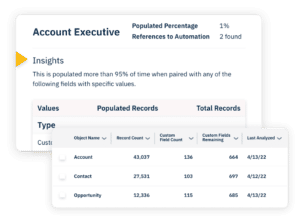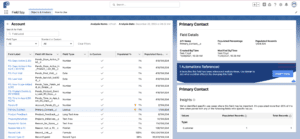Identifying unused fields… finding duplicate records… reviewing your data quality. There are many factors that can make even the most experienced admins intimidated when taking on Salesforce data cleanup.
But unfortunately, it’s a necessary evil when it comes to managing an org. While we can’t take away the intimidation of undergoing cleanup, our team at Sonar figured we might be able to make it a little easier for you. That’s why we created FieldSpy.
If you’ve downloaded the free FieldSpy app from the Salesforce AppExchange, you’re likely already in on the secret that it highlights field population and insights that make prioritizing tech debt clean up a breeze.
Below, we’re going to cover how it does this, and how FieldSpy will help you confidently make org cleanups in the future!
What is FieldSpy?
FieldSpy is a free app available on the Salesforce AppExchange that helps admins manage their orgs. This tool gives them the field population intelligence required to make those seemingly impossible Salesforce field cleaning decisions like determining which fields can stay and which fields should go.

As you undergo any cleanup project, your probably starting with a list of discovery questions, like:
- What fields are required on page layouts or by record types?
- Are there high value, under populated fields that should be considered required?
- Are there low value fields rarely used?
- Are there fields where normalization is needed to improve data integrity?
- Are there any fields that are capturing data across multiple processes?
- Are there duplicate or redundant fields?
- Are there fields that are part of a workflow, validation or other automation that aren’t necessary?
- If I delete this field, will it break anything that’s critical to my GTM team?
- Should I add help text so users have clarity into what data should be collected in a field?
The number one purpose of FieldSpy is to help you quickly find answers to these questions. It’s a clean and intuitive tool that works on both standard and custom fields across any object in Salesforce.
Using FieldSpy gives you the confidence to remove any Salesforce fields by understanding:
- How often it’s being used and populated
- Any ripple effects on other processes from that one field
- Uncommon, yet critical scenarios a field is used for
- How often it’s utilized in automated processes
FieldSpy also gives you the ability to easily run analyses across objects to speed up your Salesforce data cleansing efforts.
Optimize Salesforce Data Cleanup with FieldSpy
Cleaning your Salesforce data is no easy task, but FieldSpy makes it easier in multiple ways. Read below to learn how FieldSpy improves your Salesforce cleaning process and increases your overall data integrity.
1. Optimize Salesforce page layout
FieldSpy gives you the ability to identify and reduce any irrelevant fields in Salesforce, limit the number of required fields, and create a tidier page for your GTM teams. Removing the noise leads to faster speed to lead, improved team workflow and an overall happier Sales team.
And when you need it done ASAP, FieldSpy allows you to run field audits across several objects at one time, reducing the time spent on the cleanup process.
2. Reduce tech debt
Let’s face it— technical debt is inevitable in any business organization. Every organization’s goal is to strike a balance between technical implementations and business goals. But first, let’s quickly define tech debt.
Technical debt, or “tech debt” can be defined as the consequence that comes from prioritizing a quick release over well-planned Salesforce change. Oftentimes, quick fixes result in Salesforce admins spending more time reworking data and less time contributing to other business goals.
FieldSpy reduces labor costs spent on rework by mitigating and eliminating these Salesforce data errors. With this tool, you have complete control over data fields and can ensure the most appropriate fields are in place to be utilized.
3. Identify field usage
Monitoring your field usage before you begin cleaning up your Salesforce is important as you need visibility into which fields are in place to make informed decisions.

As you analyze your fields, consider the following questions about your Salesforce data and how FieldSpy can improve your data cleanup efforts:
→ Are the formats of field type normalized (checkbox, picklist, etc)? Yes, the format of your data fields matters. Proper formatting helps users to understand the field’s purpose, making it easier to use other fields when they are all set up in a standard format.
Using FieldSpy allows you to quickly run analyses and identify formats of field types to standardize them, making both admins’ and GTM teams’ lives easier.
→ Can you understand the dependencies on other fields? Salesforce users are much more likely to take their time entering data correctly when they see the value in it.
You can now remove irrelevant fields and make space for the necessary ones in your Salesforce using true data usage intelligence. FieldSpy gives you the opportunity to see which fields are dependent on others downstream, and which ones are simply wasting space in your Salesforce.
→ Should certain fields be used more often? It’s totally possible your GTM team isn’t using certain fields because they simply don’t realize or don’t understand what they are being used for. This presents an opportunity for you to add help text to better describe what data should be collected in the specific field. If you haven’t upgraded from FieldSpy to Sonar already, our Data Dictionary makes updating field descriptions and help text a breeze! See how here.
With FieldSpy, you no longer have to guess or make assumptions about which fields are actually being used for certain Salesforce functions. This free app gives you clear, exact field usage statistics to provide guidance during both your SalesForce cleanup and GTM training efforts. Remove the noise of irrelevant fields and provide clear guidance on the importance of others to your Salesforce org.
Bottom line— removing noisy fields from your Salesforce data will not only clean up your org but will make it easier for admins to maintain in the future.
4. Maintain compliance
Are you unnecessarily collecting Personal Identifier Information (PII)? You know, data like the social security number of clients you haven’t done business with in 6+ years? If it doesn’t serve you or your customer, it’s best to clean it up and let it go.
Racking up unnecessary PII not only takes up space in your Salesforce org, but it also creates the possibility of a data breach. There is no reason to keep any PII in your system you don’t need for your business. With just a few clicks, FieldSpy offers you the ability to maintain compliance with a simple and fast audit process.
Conclusion: Take Data Cleanup to the Next Level with Sonar
Now that you have FieldSpy in your toolkit, you’ll feel a lot more confident managing your Salesforce field cleanup projects as you can:
→ Save time: Quickly analyze fields, giving you more time to prioritize other work
→ Analyze trends: Analyze trends across all fields to get a holistic view of field usage
→ Mitigate tech debt: Get rid of outdated data and improve data hygiene
→ Speed up clean-up projects: Quickly identify unused fields across your org
→ Gain powerful insights: Use the Insight feature to uncover fields you should keep
Of course, FieldSpy is just the tip of the iceberg when it comes to getting a holistic view of your Salesforce Org. Pair it with Sonar to see how any change within your instance– automations, fields, reports and more– will impact your GTM teams downstream.

